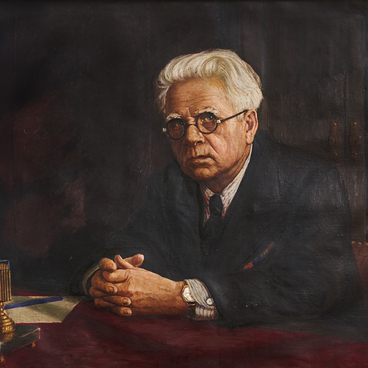Special samovar trays were one of the main accessories for tea drinking in Russia. A samovar was put on the tray, which prevented damage from sparks of hot coals so that the table surface remained intact. A samovar tray was used to bring the drip bowl necessary for tea drinking — it was used to collect water droplets from the samovar faucet and wash glasses, tea cups and other items.
A samovar tray produced by the partnership of Kolchugin’s factories is presented in the interior of the “Trading Shop”. Alexander Grigoryevich Kolchugin, a merchant of the 2nd guild, founded a copper and brass factory in the Vladimir governorate in 1876. The workers’ settlement, which arose around the enterprise under construction, was named after him — Kolchugino (now it is the city of Kolchugino, Vladimir Oblast). The factory’s products had a wide range, including samovars and samovar accessories. This enterprise exists today as a modernized factory.
According to the classification generally accepted at that time, the tray in the form of a horseshoe (bullet) was small and was intended to accommodate a small-capacity samovar. On the front surface of the item, at the bottom, there are factory marks, including “No. 1”. Numbers on samovar accessories depended on their type, shape and size. The samovar was put at the straight edge of the tray, the drip bowl — at the semicircular one. The high edge of the tray around the entire perimeter of the object, is rounded outwards.
Near the lower border of the product, there are factory marks: a pair of the Great State Emblems in the form of a double-headed eagle with the dates “1882” and “1896”. During those years, All-Russian art and industrial exhibitions were held in Moscow and Nizhny Novgorod, at which the presented products of the Kolchugin partnership were awarded the highest state award for quality, which gave the laureates the honorary right to feature an exact copy of the Russian coat of arms on their products. For mass consumers, the Great State Emblem on the product signified product quality. Above the coats of arms, there is an inscription in two semi-ovals “Kolchugin’s Partnership”.
A samovar tray produced by the partnership of Kolchugin’s factories is presented in the interior of the “Trading Shop”. Alexander Grigoryevich Kolchugin, a merchant of the 2nd guild, founded a copper and brass factory in the Vladimir governorate in 1876. The workers’ settlement, which arose around the enterprise under construction, was named after him — Kolchugino (now it is the city of Kolchugino, Vladimir Oblast). The factory’s products had a wide range, including samovars and samovar accessories. This enterprise exists today as a modernized factory.
According to the classification generally accepted at that time, the tray in the form of a horseshoe (bullet) was small and was intended to accommodate a small-capacity samovar. On the front surface of the item, at the bottom, there are factory marks, including “No. 1”. Numbers on samovar accessories depended on their type, shape and size. The samovar was put at the straight edge of the tray, the drip bowl — at the semicircular one. The high edge of the tray around the entire perimeter of the object, is rounded outwards.
Near the lower border of the product, there are factory marks: a pair of the Great State Emblems in the form of a double-headed eagle with the dates “1882” and “1896”. During those years, All-Russian art and industrial exhibitions were held in Moscow and Nizhny Novgorod, at which the presented products of the Kolchugin partnership were awarded the highest state award for quality, which gave the laureates the honorary right to feature an exact copy of the Russian coat of arms on their products. For mass consumers, the Great State Emblem on the product signified product quality. Above the coats of arms, there is an inscription in two semi-ovals “Kolchugin’s Partnership”.



